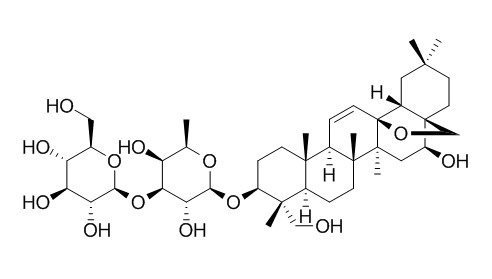Natural Products
Saikosaponin A
| Catalog No. | CFN99987 |  |
| CAS No. | 20736-09-8 | |
| Molecular Weight: | 780.99 | |
| Molecular Formula | C42H68O13 | |
| DBs | [PubChem]:11167 [ChEMBL]:8996 [PCIDB]:3548 |
Standard InChI:
InChI=1S/C42H68O13/c1-21-28(46)33(55-34-31(49)30(48)29(47)22(18-43)53-34)32(50)35(52-21)54-27-10-11-37(4)23(38(27,5)19-44)8-12-39(6)24(37)9-13-42-25-16-36(2,3)14-15-41(25,20-51-42)26(45)17-40(39,42)7/h9,13,21-35,43-50H,8,10-12,14-20H2,1-7H3/t21-,22-,23-,24-,25-,26+,27+,28+,29-,30+,31-,32-,33+,34+,35+,37+,38+,39-,40+,41-,42+/m1/s1
Biological Activity
Saikosaponin A (SSa), a main constituent of the Chinese herb Bupleurum chinense DC, has antiepileptic activity,could inhibit NMDA receptor current and persistent sodium current, and inhibit epileptiform discharges induced by 4AP in a dose-dependent manner.[1]
Saikosaponin A has anti-inflammatory activity,can decrease PMA plus A23187-induced cysteine-aspartic acid protease (caspase)-1 activity, and the number of nasal rubs and serum TNF-α level in the ovalbumin-sensitized allergic rhinitis mouse model, and inhibit the IL-1β production.[2]
Saikosaponin A extends to alcohol self-administration the capacity to suppress morphine and cocaine self-administration in rats ,the GABA B receptor system is likely part of the neural substrate underlying the reducing effect of SSA on alcohol self-administration. [3]
Saikosaponin A as antioxidants improve antioxidant status. Supplementation with curcumin and/or saikosaponin A suppress inflammation and fibrogenesis in rats with CCl(4)-induced liver injury. However, the combination has no additive effects on anti-inflammation and antifibrosis.[4]
Product
References
[1] Xie W, Yu Y H, Du Y P, et al. Evid-Based Compl Al, 2013, 2013(1):221-229.
[2] Han N R, Kim H M, Jeong H J.Biol Pharm Bull, 2011, 34(6):817-23.
[3] Maccioni P, Lorrai I, Carai M A M, et al. Neurosci Lett, 2016, 621:62-67.
[4] Shu-JuWu, Ka-WaiTam, Ya-HuiTsai, et al. Am J Chinese Med, 2012, 38(1):99-111.
[5] Tang Y H, Zhang Y Y, Zhu H Y, et al. Biomed Chromatogr, 2007, 21(5):458-62.
Product Use Citation





